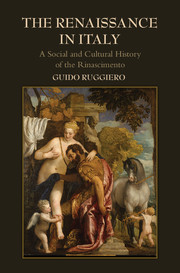Book contents
- Frontmatter
- Dedication
- Contents
- List of Illustrations
- Acknowledgments
- Maps
- Introduction: The End of the World and Its Rebirth (Rinascita) as the Rinascimento
- 1 Legitimacy: A Crisis and a Promise (c. 1250–c. 1340)
- 2 Civiltà: Living and Thinking the City (c. 1300–c. 1375)
- 3 Plague: Death, Disaster, and the Rinascita of Civiltà (c. 1325–c. 1425)
- 4 Violence: Social Conflict and the Italian Hundred Years’ War (c. 1350–1454)
- 5 Imagination: The Shared Primary Culture of the Early Rinascimento (c. 1350–c. 1475)
- 6 Courts: Princes, Aristocrats, and Quiet Glory (c. 1425–c. 1500)
- 7 Self: The Individual as a Work of Art (c. 1425–c. 1525)
- 8 Discovery: Finding the Old in the New (c. 1450–c. 1560)
- 9 Re-Dreams: Virtù, Saving the Rinascimento, and the Satyr in the Garden (c. 1500–c. 1560)
- 10 Reform: Spiritual Enthusiasms, Discipline, and a Church Militant (c. 1500–c. 1575)
- 11 Retreat: The Great Social Divide and the End of the Rinascimento (c. 1525–c. 1575)
- Epilogue: The Diaspora of the Rinascimento
- Bibliography: A Short List of Works Used
- Index
3 - Plague: Death, Disaster, and the Rinascita of Civiltà (c. 1325–c. 1425)
Published online by Cambridge University Press: 05 December 2014
- Frontmatter
- Dedication
- Contents
- List of Illustrations
- Acknowledgments
- Maps
- Introduction: The End of the World and Its Rebirth (Rinascita) as the Rinascimento
- 1 Legitimacy: A Crisis and a Promise (c. 1250–c. 1340)
- 2 Civiltà: Living and Thinking the City (c. 1300–c. 1375)
- 3 Plague: Death, Disaster, and the Rinascita of Civiltà (c. 1325–c. 1425)
- 4 Violence: Social Conflict and the Italian Hundred Years’ War (c. 1350–1454)
- 5 Imagination: The Shared Primary Culture of the Early Rinascimento (c. 1350–c. 1475)
- 6 Courts: Princes, Aristocrats, and Quiet Glory (c. 1425–c. 1500)
- 7 Self: The Individual as a Work of Art (c. 1425–c. 1525)
- 8 Discovery: Finding the Old in the New (c. 1450–c. 1560)
- 9 Re-Dreams: Virtù, Saving the Rinascimento, and the Satyr in the Garden (c. 1500–c. 1560)
- 10 Reform: Spiritual Enthusiasms, Discipline, and a Church Militant (c. 1500–c. 1575)
- 11 Retreat: The Great Social Divide and the End of the Rinascimento (c. 1525–c. 1575)
- Epilogue: The Diaspora of the Rinascimento
- Bibliography: A Short List of Works Used
- Index
Summary
Apocalypse Now: Portraying the Plague and the Breakdown of Civiltà
I say, then, that there had passed 1348 years after the incarnation of the Son of God, when in the famous city of Florence … there struck the deadly plague (mortifera pestilenza). Whether caused by the stars or the wrath of God to correct the sins of humanity, it had appeared a few years earlier in the East, killing an infinite number. Moving terribly to the West …. [when it arrived in Florence] it appeared in a different form. In the East if anyone had blood coming from their nose, it was a sure sign of death; but [in Florence] instead in both men and women it began either in the groin or under the armpits with certain swellings, some of which grew to approximately the size of an apple, others to that of an egg. They were called by common people gavòccioli (plague sores). From those two parts of the body quickly they grew and spread over the whole body.
After a while, however, the nature of this disease changed with black spots or livid patches which appeared in great number on the arms, the thighs and all over the body, some were large and distant from each other, others small and close together. As the plague sores were a certain sign of death, so were these later symptoms…. Actually virtually everyone within about three days of the appearance of these signs died and most without a fever or other symptoms…. Oh how many great palaces, beautiful houses, noble residences once full of families, of lords and ladies became vacant…. Oh how many important families, very rich inheritances, famous fortunes, were left without their just heirs!
[Boccaccio, Decameron, Day I Introduction]- Type
- Chapter
- Information
- The Renaissance in ItalyA Social and Cultural History of the Rinascimento, pp. 116 - 153Publisher: Cambridge University PressPrint publication year: 2014



